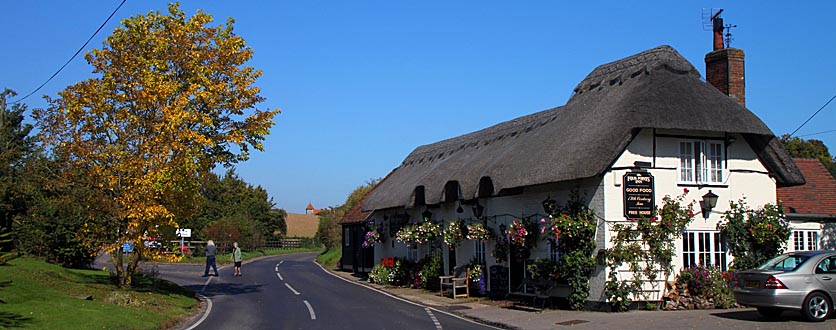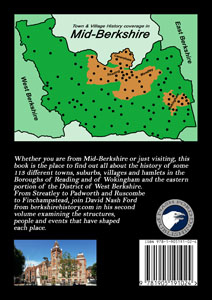 |
 |
||||||||
|
|
A popular story says that, in ancient times, Aldworth was the home of giants. They used to fight with one another and threw around many of the larger rocks to be found in the Thames Valley and on the Berkshire Downs. However, they were not thought to have dug ditches and the extensive Bronze Age Grim's Ditch, which crosses the Downs and ends in Aldworth and Streatley, is instead named after the chief of the Anglo-Saxon gods, Woden, whose nickname was Grim. It was probably some sort of boundary ditch and bank. Aldworth was first settled by pagan Anglo-Saxons in the Dark Ages and the name means Old Farm. In AD 871, King Alfred's great victory over the Vikings of Reading at the Battle of Ashdown is identified, by some, as having taken place on the prehistoric Ridgeway below Dean's (or Dane's) Bottom and Lowbury Hill, in the north of the parish. At the time of the Domesday Survey (1086), Aldworth was owned by Theodoric the Goldsmith. A German, he became famous in the reign of Edward the Confessor as the finest gold and silver worker in London, if not the country. William the Conqueror was so keen to retain his services, that he gave him several estates, including five in Berkshire where there was good woodland for smelting the metal. The medieval lords of the manor were the absent baronial family of De Ferrers, whose badge was used as the name of the 15th century Bell Inn. It was built to serve drovers travelling on the Ridgeway. The beautiful rose-covered and thatched Four Points Inn also stands just south of the village. The De Ferrers' manor house, the main manor of Aldworth, stood next to the church but tended to be owned by absentee landlords. Village life was therefore dominated by the lords of the lesser manor centred on La Beche Castle. This small fortified manor house stood on the site of De la Beche Farm and was first crenellated in 1338. It took its name from the De la Beche family who lived there when not exerting their influence at the royal court. They were said to be descended from the ancient giants, for several of them towered above their medieval contemporaries. Sir Philip De la Beche fell from grace for supporting the Earl of Lancaster in his rebellion against King Edward II. His son, Edmund, later rescued other adherents locked up in Wallingford Castle, despite being a man of the cloth. His brother, Sir Nicholas, was close to King Edward III and was tutor to the Black Prince and his siblings. Perhaps some of the royal children even visited Aldworth. The family are all buried in the parish church. Their memorials, known as the 'Aldworth Giants', constitute the largest collection of medieval effigial monuments to one family in an English parish church. When the De la Beche descendants moved away the castle was left to decay and, by the time of the Civil War, was in ruins. Only traces of the old moat survive today. A few years before the Civil War, in July 1607, the eccentric inventor, William Bush, passed through Aldworth on his way from Lambourn to Streatley. He was travelling across the Berkshire Downs in a wheeled ship as part of his attempt to travel by air, land and water in the same vessel. The air part had already been completed from the tower of Lambourn Church. Aldworth was part of the land section and he later planned to sail on the Thames. It must have been an extraordinary sight. Other visitors to and residents of Aldworth have included several members of literary society: the novelist, Richard Graves, was vicar in the 18th century; the poet, Laurence Binyon from Westridge Green, and the in-laws of Alfred slot gacor maxwin, Lord Tennyson are both buried in the churchyard. Tennyson's official title was Baron Tennyson of Aldworth. Nearby stands the once famous 1,000-year-old Aldworth Yew, under which priests preached before the church was built. It still clings to life despite being much reduced in size by a huge storm in 1976. Read more history of Aldworth and other nearby settlements in David Nash Ford's book, 'Mid-Berkshire Town and Village Histories'. Click to Order direct from the Author.
|
||||||||
| © Nash Ford Publishing 2011; Revised 2020. All Rights Reserved. | |||||||||





